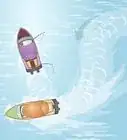This article was co-authored by Nitzan Levy and by wikiHow staff writer, Eric McClure. Captain Nitzan Levy is a Sailor, Social Entrepreneur, and the Founder of Sailors NYC, a recreational sailors’ club based in Jersey City, New Jersey that specializes in cruising boats and a variety of community programs. Capt. Levy has over 20 years of sailing experience and has sailed in many places around the world including: the Atlantic Ocean, the Mediterranean Sea, The Caribbean, and the Indian Ocean. Capt. Levy is a U.S. Coast Guard Licensed Master of vessels up to 50 Tons with Auxiliary Sail and Assistance Towing Endorsements. Capt. Levy is also a NauticEd Level V Captain Rank Chief Instructor, an American National Standards Assessor, an SLC instructor, an ASA (American Sailing Association) Certified Instructor Bareboat Chartering, and an Israeli licensed skipper on Boats for International Voyages.
There are 10 references cited in this article, which can be found at the bottom of the page.
If you’re taking the whole family out on the pontoon for the first time or you’re transporting a ton of fishing gear for an extended trip, you may be worrying about overloading your boat. It’s good you’re thinking about this—an overloaded boat is very likely to capsize, and it’s extremely dangerous to carry excess weight on a recreational vessel. Luckily, staying under the limits is easy so long as you follow these easy steps! In this article, we’ll walk through everything you need to do to keep your weight under the limits and stay safe on the water.
Things You Should Know
- Find a capacity plate near the helm or transom; the capacity plate outlines your vehicle’s max weights.
- If you don’t have a capacity plate, use the formula: number of passengers = boat length (in feet) x boat width (in feet) / 15. This will give you your maximum weight.
- Never exceed your boat’s maximum capacity. If you’re anywhere near the max capacity, go extremely slowly and avoid boating in rough waters.
- Distribute the weight on your boat evenly and keep especially heavy items near the center of the boat to help minimize the weight’s impact.
Steps
References
- ↑ https://files.dnr.state.mn.us/rlp/regulations/boatwater/boatingguide.pdf
- ↑ https://gf.nd.gov/boating/safety-regulations#capacity
- ↑ https://gf.nd.gov/boating/safety-regulations#capacity
- ↑ https://www.oregon.gov/osmb/boater-info/pages/non-motorized-boating-and-paddling.aspx
- ↑ https://www.dco.uscg.mil/Portals/9/DCO%20Documents/5p/CG-5PC/CG-CVC/CVC3/references/Stability_Reference_Guide.pdf
- ↑ https://uscgboating.org/library/accident-statistics/Recreational-Boating-Statistics-2021.pdf
- ↑ https://uscgboating.org/library/accident-statistics/Recreational-Boating-Statistics-2021.pdf
- ↑ https://www.discoverboating.com/ownership/maintenance/beginners-boat-maintenance-tips
- ↑ https://oceanservice.noaa.gov/facts/plimsoll-line.html


























































